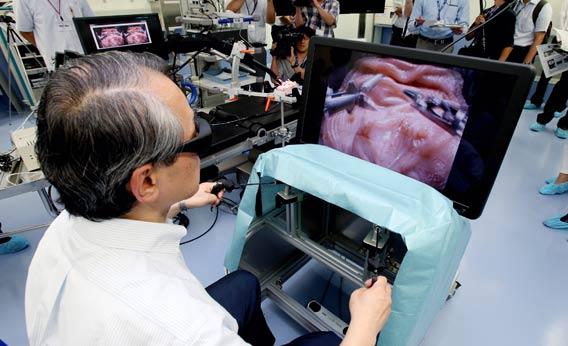(Image source: Makezine 2013)
Who else is amazed by the advancements made in the fields of science, medicine and technology? Almost every week we hear of a new development, invention or discovery that can really revolutionize our lives. One technology that has truly amazed us is long-distance robotic surgery. What is long-distance robotic surgery you ask? It is where a doctor or a surgeon who is in another city, country or even continent performs a surgery on you hundreds or thousands of kilometres away.
Just think of the possibilities! It will allow you access to world-leading experts and better health care services WITHOUT having to leave your city! How beneficial would this be for some people? Especially those who are not comfortable in travelling to access the health care services they so badly need?
The first successful long-distance robotic surgery
In 2001, the very first successful long-distance robotic surgery (also known as telesurgery) was performed. Surgeons in New York conducted a surgery to remove a patient’s gallbladder based in France. The field of long-distance robotic surgery has taken since then and though it is not yet the industry standard, sales of medical robots are increasing 20% year on year and by 2025, the US Government’s Department of Defense wants to have deployable Trauma Pods that could allow surgeons to operate on soldiers from hundreds or thousands of miles away! There’s a very neat 3-part video which I’ve included at the bottom of this article which shows you what Trauma Pods can do.
The birth of telesurgery
The birth of telesurgery didn’t just happen with everyday procedures in mind. In fact, it was issues away from Earth that got the robotic doctor innovation progressing. As soon as people began to truly consider human spaceflight, they started to wonder how they might treat a human thousands of miles away from any doctor. In the 1970s, NASA suggested that researchers look into the option of remote controlled robots which are able to operate on astronauts in outer space. Since then, NASA and the US Army have worked together to create reliable robots that could operate on somebody miles and miles away.
The da Vinci robot
In recent years, the first market-ready robotic surgeon called the da Vinci system has been introduced, usually controlled by a surgeon nearby. Some of our health care providers are already using this technology to operate on their patients. They have expressed that with the da Vinci robot, they have been able to work on their patients more precisely as they are able to zoom in on certain locations which would traditionally be rather challenging.
Vulnerabilities of telesurgery
Though supporters of robotic surgery have thoroughly discussed its benefits – such as no delay due to travel time, and surgery could be possible in remote locations like deep underwater or in outer space, and access to the best doctors around the world; there hasn’t been much investigation into its weaknesses. This is why researchers at the University of Washington decided to put the telesurgery technology to the test, to see if they were susceptible to cyber attacks and what would a cyber attack mean for the surgeon and the patient involved.
Putting telesurgery technology to the test
According to their study, the security of surgical robots leaves much to be desired. By hacking the router that connected the surgeon to the robot, researchers were able to change the commands so that the robot’s motions were jerky and erratic. They made the movements longer or shorter than the surgeon intended. It could also trigger an automatic stop mechanism that prevented the surgery from continuing, and eventually, the researchers were able to take over the controls from the surgeon completely. They also found that the video connection that allowed the surgeon to see what she was operating on was publicly accessible. This raised many questions of the patient’s privacy and what can be done to minimize the risks.
Since surgery is so delicate and precise, any type of attack at a critical moment could be lethal for a patient. The researchers suggested a number of ways that telesurgery can be more secure, including encrypting data as it’s transferred from surgeon to robot, making the software more sensitive to errors and attempted data changes, and better monitoring of the network status before and during surgery. These changes wouldn’t make the robots immune to attacks, but would be a big step in the right direction. Having this conversation and putting security policies in place is essential before telesurgery becomes the norm. Who would feel safe undergoing telesurgery if its vulnerabilities weren’t resolved?
Another concern addressed by a researcher – Tamas haidegger, who studies space telesurgery at Obuda University in Budapest is lag times. Although better landlines and advanced hard-wired internet connections have made lag times less of an issue, with distance comes more lag time, and any interruption will pose a disaster risk. Haidegger says that should anything happen as a result of lag times, “it’s not realistic to expect these robots to go into autopilot mode and finish the surgery.”
There are already so many risks associated with a typical surgery that even with a master surgical plan, things can go wrong. “We can’t predict what’s going to happen in an advanced stage of surgery. If blood circulation collapses, breathing stops, or there’s an unforeseen reaction to drugs or chemicals, these are cases that you need a trained surgeon on site,” says Haidegger.
So will future operations be done by somebody in another hospital, or even another country or planet? “The science is already there,” according to Dr. Mehran Anvari of St Joseph’s Hospital in Hamilton, Canada, “the other stuff is what’s holding us back.”
Would you be comfortable with a surgeon you have never met face-to-face perform a cardiac surgery or a kidney transplant procedure on you? What are your thoughts about telesurgery? Are you a surgeon who performs telesurgery? Tell us what you think and share with us your stories by e-mailing us at: [email protected].
If you don’t want to miss out on any updates and other exciting news about the medical travel world, subscribe to our newsletter below! You just might also be privy to special offers just for subscribing!













